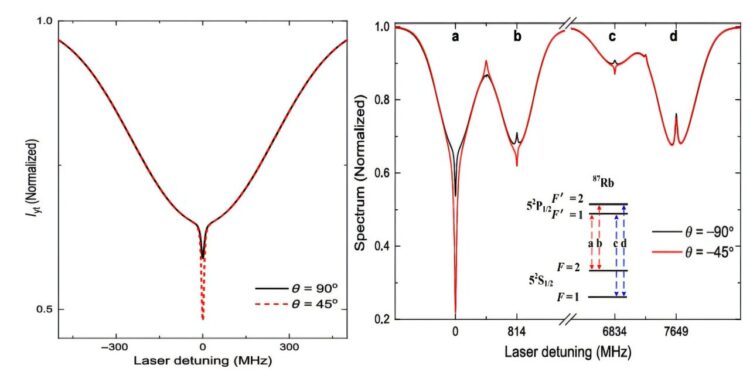Spectroscopic signals calculated theoretically (left) and observed experimentally (right) in the proposed method. Credit: Peter Yun
A research team on the atomic clock of the National Time Service Center of the Chinese Academy of Sciences has proposed and implemented a compact optical clock based on an improved quantum absorption spectroscopy, which should play an important role in micro-positioning, navigation, calendar (μpnt) and other systems.
Inspired by the successful history of the microwave atomic clock at the scale of coherent chips (CPT) and the madness of optical microcombs, an optical clock on a flea scale has also been proposed and demonstrated with better stability and precision of the frequency, which is mainly based on the transition to two photons of the Atom of Rubidium Atom.
However, high cellular temperatures generally necessary (~ 100 ℃) and the laser powers (~ 10 MW) in such a configuration do not comply with the advent of an entirely miniaturized and low power optical clock.
To respond to these limitations, researchers have developed an innovative approach that uses improved absorption subdoppler resonances on the D1 Rubidium atom line.
Using monochromatic light and polarization parameters carefully paid for pump and counter-propagation probe bundles, the researchers observed improved absorption due to constructive or destructive interference between two dark states prepared by the pump and probe bundles, respectively. The resonance without doppler improved by absorption absorption with a high ratio of amplitude of the signal to the line width is favorable for the implementation of optical clocks with high performance.
Compact optical clocks implemented with improved absorption of underdoply resonances, experimental configuration (left) and the stability of the measured laser frequency (right). Credit: Peter Yun
In addition, the spectroscopic lines are obtained for modest laser powers (approximately 100 µW) and cell temperatures (around 40 ℃) – all the characteristics of a significant interest in demonstrating a compact optical reference.
Researchers have presented a theoretical model that highlights the significant contribution of Zeeman’s dark states in this spectroscopy. And the theoretically calculated spectroscopic signals are well suitable with experimental observations.
To measure the frequency stability of this optical clock, two identical diode lasers have been stabilized in frequency on improved absorption underdoply resonances. The influence of key parameters on the underdoply resonance characteristics is fully studied. Using this simple architecture configuration, the researchers demonstrated the Laser Beat Locked Locked Bad with a split frequency stability of 1.8 x 10−12 to 1 s and less than 10−11 At 10,000 s, which is improved by more than two orders of magnitude compared to the free box.
These results demonstrate the potential of this scheme for the implementation of a compact optical frequency reference or even on the chip scale, which could find applications in instrumentation, navigation and metrology.
This work is a collaboration with Professor Rodolphe Boudot of Franche-Comté electronic thermal and optical mechanical-sciences and technologies of technologies (FEMTO-ST) in France, and the results are published in Applied physical review.
More information:
Peter Yun et al, improved absorption in spectroscopy without doppler of the D1 line of the RB atom with monochromatic light: application to the stabilization of laser-frequency, Applied physical review (2025). DOI: 10.1103 / Physrevaplled.23.034063
Supplied by the Chinese Academy of Sciences
Quote: The compact optical clock uses quantum interference for better frequency stability (2025, April 28) recovered on April 28, 2025 from
This document is subject to copyright. In addition to any fair program for private or research purposes, no part can be reproduced without written authorization. The content is provided only for information purposes.



